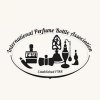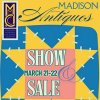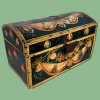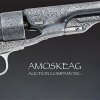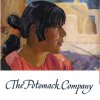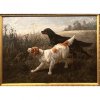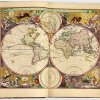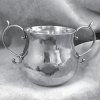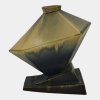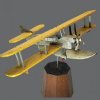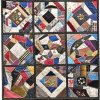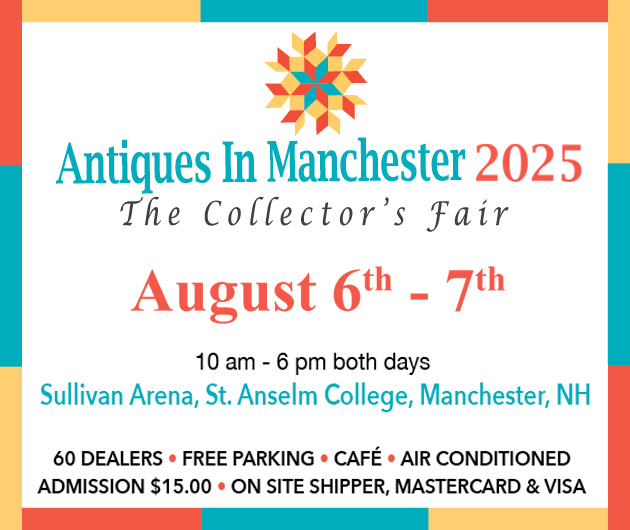Hadley Chest, Rich and Mellow
January 22nd, 2016
Christie’s, New York City
Photos courtesy Christie’s
Christie’s sale on January 22 in New York City, culled from various sources, was a small one but not without excitement. The offering of the oak and polychrome Hadley chest was big news. Twelve years ago John Hays, then Christie’s head of American furniture, now deputy chairman, learned of its existence. He sent Martha Willoughby out to California to see it, but it was not for sale.
“I kept in touch with the owners every year, and finally it was time to sell it,” said Hays last fall, when he asked Susan Buck, a conservator, to study its surface and to take microscopic paint samples and confirm that it has the most complete untouched painted surface to survive from the earliest years of the 18th century.
The estimate was “on request” and said to be $500,000/1,000,000 to encourage bidding. It was expected to go way over a million. Bidding opened at $320,000, and a phone bidder and two bidders in the room took it to $850,000. Dealer Deanne Levison of Atlanta, seated in the salesroom with clients, was the winner. Bradley C. Brooks, curator of Bayou Bend in Houston, standing at the back of the salesroom was the underbidder. When the buyer’s premium was added, the total came to $1,025,000. Some thought it might bring twice that, but it takes a long time for institutions to get their donors in line. Those who wished they had bid were sorry they were not in the salesroom.

This circa 1715 Hadley chest has two drawers, is 43½" x 43" x 18½", and was possibly owned by a member of the Barnard or Williams families of Hadley and Deerfield, Massachusetts. John Hays of Christie’s learned of its existence in California 12 years ago, and it had never been offered at auction previously. It sold in the salesroom for $1,025,000 to dealer Deanne Levison of Atlanta, bidding for clients.
Its original painted decoration is intact and it has no overpaint, according to conservator Susan Buck. Its design and decoration is derived from the carved Hadley chest tradition that flourished in the northern Connecticut River valley in the early years of the 18th century. Three other chests painted by the same hand are known. All are in museum collections. One is named after Hannah Barnard of Hadley and is at the Pocumtuck Valley Memorial Association in Deerfield. It and another Hadley chest at Winterthur have suffered losses and overpainting. This chest was considerably more vibrant when it was new. According to the catalog, delftware plates may have been the source for lobed floral design on the drawers. The dart board designs, however, do not appear on other Hadley chests. All these chests were made for the ruling elite of Hadley. This chest was the property of a family whose ancestors include several members of the Porter, Barnard, and Williams families. It is likely that until its inclusion in this sale, this chest had never been out of the family for which it was made.
Deanne Levison said it will go to a great collection and be cared for. “It will not be conserved, since it is a remarkable survivor [with] a rich and mellow color,” she said. When it was new, it must have been bright and daring.
Great American furniture rarely crosses the million-dollar threshold. The Hadley chest was the most expensive piece of furniture sold during Americana Week in New York City in 2016 and the 67th piece of American furniture on the million-dollar list. It is the second-highest price paid for Pilgrim Century furniture; only the Pope valuables chest, which sold at Christie’s for $2,422,500 in January 2000, brought more. It was the second-highest price paid for a piece of American painted furniture. It was topped by the $2,928,000 paid for the diminutive paint-decorated Taunton chest of drawers, dated 1729, that sold at the Mrs. J. Insley Blair sale at Christie’s in 2006 at the peak of the market in a very different economic climate. The earliest American furniture is a very special and very thin market.
Levison was also the winning bidder for another fine piece of early furniture: a William and Mary mahogany and maple dressing table made in Philadelphia between 1700 and 1730. It sold for $665,000 (est. $250,000/500,000), underbid by editor/consultant Luke Beckerdite of Virginia, who was a competitive bidder at all the January sales. The dressing table has bold turnings, energized stretchers, one long drawer with old drop brasses, and a dark old surface, all very appealing.
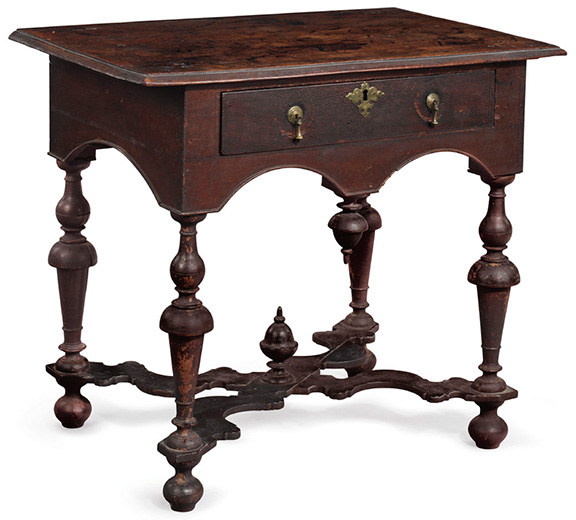
This 1700-30 Philadelphia William and Mary mahogany dressing table with turnings of local maple is 28" x 32½" x 20¾" and sold for $665,000 (est. $250,000/500,000) to Deanne Levison for the same clients who were in the salesroom and bought the Hadley chest. The unusual stretcher design is seen on two other baroque dressing tables (one at Chipstone and the other at the Philadelphia Museum of Art) and most likely made at the same shop. Alan Miller is quoted as saying that the uneven widths of the arches on the stretchers create a sense of tension and momentum. The single long drawer is a rare feature that indicates an early date, closer to 1700. Two others survive (one at Yale, the other at the Metropolitan Museum of Art). It likely was fitted with a molding running below the drawer and continuing on the case sides. It is cited by Wallace Nutting as having been owned in the early 20th century by Edward Croydon Wheeler Jr., a stockbroker and antiques dealer in Boston.
William Stahl of Millbrook, New York, is a consultant and had little competition for a tall Queen Anne compass-seat walnut armchair made in Philadelphia, circa 1755, deaccessioned by the Philadelphia Museum of Art. He bought it for a client for $545,000 (est. $500,000/800,000), a good buy.
There were other good buys at much lower prices. An experienced collector paid $12,500 (est. $5000/10,000) for a Salem, Massachusetts, mahogany drop-leaf dining table with ball-and-claw feet, attributed to John Chipman, in top condition, with hinges marked “SW” (an English maker) and with all its glue blocks in place and little wear. Winterthur’s Brock Jobe said there is no table finer of this type.
Another seasoned collector, doing his own bidding, paid $6875 (est. $5000/10,000) for a Philadelphia tilt-top tea table with snake feet, a suppressed ball central column with no carving (in the Quaker manner), and a dark rich surface.
 A number of lots came from the Rosebrook collection, which was amassed by Mr. and Mrs. Philip Caldwell, who began to collect with the help of Jess Pavey when Philip Caldwell was president of Ford Motor Company. When Caldwell retired and they moved to New Canaan, Connecticut, they bought primarily from Wayne Pratt.
A number of lots came from the Rosebrook collection, which was amassed by Mr. and Mrs. Philip Caldwell, who began to collect with the help of Jess Pavey when Philip Caldwell was president of Ford Motor Company. When Caldwell retired and they moved to New Canaan, Connecticut, they bought primarily from Wayne Pratt.
A mahogany turret-top tea table was part of the Rosebrook collection. Two phone bidders competed for it. It sold for $485,000 (est. $300,000/500,000). It is a rare form, much studied and questioned in the last 20 years, for instance in the article “Boston Turret-Top Tea Tables” by Brock Jobe and Allan Breed in their forthcoming book Boston Furniture, 1700-1900. According to the catalog, its moldings have been replaced.
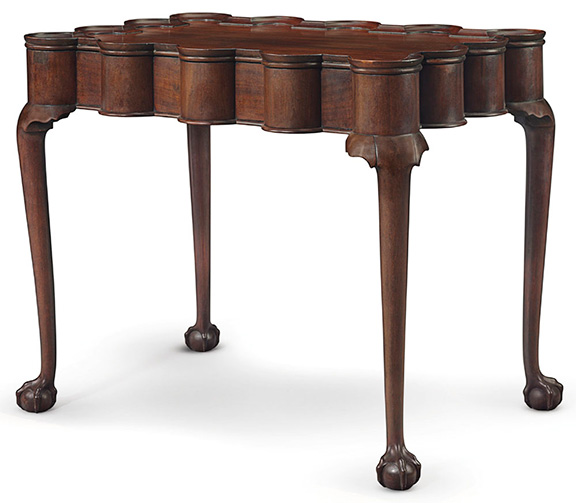
A labor-intensive and costly form to make, few turret-top tea tables were created. This is one of five turret-top 18th-century tables known. The other four are in museums—Winterthur, Historic Deerfield, Bayou Bend, and at the Museum of Fine Arts, Boston (MFA). It is a Boston form. This one is mahogany, 1750-60, 26½" x 21 5/8" x 31", and from the Rosebrook collection. It sold for $485,000 (est. $300,000/500,000). This one was probably made in the same shop as one at the MFA and may be the earlier of the two types; this one and one not yet on display at the MFA have applied moldings. The one at Winterthur has the molding carved as one with the top. All of these tables were designed to accommodate tea cups; the example at Winterthur came with its original tea service. The moldings on this one were replaced, according to the catalog. The one in the Karolik collection at the MFA is now thought to be a fake, according to Brock Jobe. This one and the other at the MFA were at one time thought to be later copies, but Brock Jobe and Allan Breed have written about them in a forthcoming book on Massachusetts furniture, saying they are indeed period but have restored moldings.
Federal furniture performed badly. For example, a mahogany and satinwood card table attributed to the shop of John and Thomas Seymour of Boston, 1800-10, sold for $18,750 (est. $20,000/30,000) to a bidder who left a written bid with the auctioneer. A Federal armchair, the carving attributed to Samuel McIntire of Salem, Massachusetts, failed to sell, and so did a circa 1811 Federal sideboard attributed to William Lloyd of Springfield, Massachusetts. There was no bid above $900 for a Vermont chest of drawers with the backboards inscribed in pencil “Wm. J H Cleveland / White River Junc. / VT.” It failed to sell even though there was an exhibition of signed Vermont furniture at Shelburne Museum last summer with an accompanying book.
There was competition for a circa 1801 Federal mahogany window stool attributed to Samuel McIntire, and it sold on the phone to the trade for $30,000 (est. $12,000/18,000), underbid by a young couple from Atlanta in the salesroom.
Of the 137 lots of furniture from various owners offered in the catalog, 107 sold. Various-owners’ silver filled the rest of the catalog, and it was offered on Friday afternoon after the Zaitz sale concluded. Of the 62 lots of silver, two were withdrawn and 47 sold. The total for silver was included in the furniture grand total of $4,490,485; about 78% of lots sold overall.
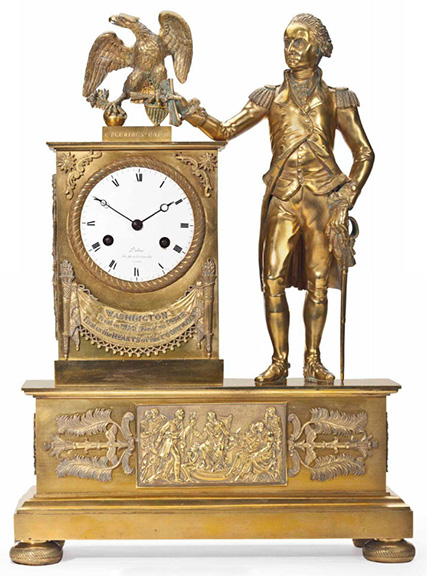
This French ormolu mantel clock with a figure of George Washington has a white enamel dial signed by Jacques Nicolas Pierre François Dubuc, “Dubuc / Rue Michel Le Compte, No. 33 / A PARIS.” The1815-19 clock is 19½" high, 14½" wide, 5½" deep and sold to a collector in the salesroom for $68,750 (est. $40,000/60,000). It was consigned by a South American family who had owned it for over 60 years and was said to have been given to them as collateral for a debt never paid. Over 30 of these Washington clocks survive; this is the larger model. The banner below quotes General Henry Lee’s oration at Washington’s funeral, “First in war / First in Peace / First in the Hearts of his Countrymen,” and the frieze shows Washington relinquishing his sword, a reference to the Roman citizen soldier Cincinnatus.
Early silver rarely comes up for auction. This resulted in piqued interest in a previously unrecorded circa 1740 sugar bowl and cover in the form of a Chinese tea/rice bowl with the mark of Jacob Hurd of Boston. It sold to a phone bidder for $27,500 (est. $25,000/35,000). Old South Church in Boston consigned a rare silver beaker with the marks of John Hull and Robert Sanderson, 1660-75, and it sold to another phone bidder without much competition for $47,500 (est. $40,000/60,000).
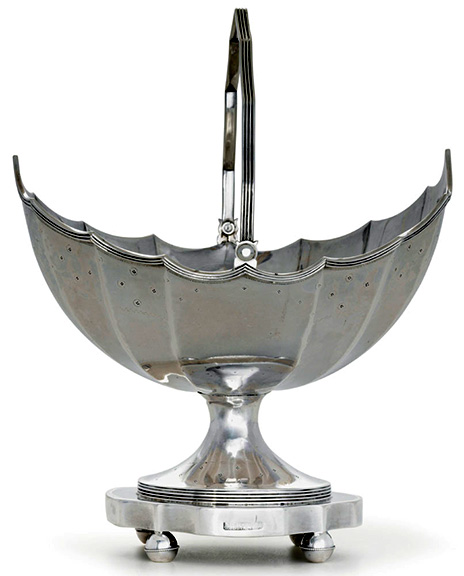
This silver sugar basket with the mark of Richards & Williamson, Philadelphia, circa 1800, sold to a phone bidder for $2000 (est. $700/1000). The reeded body has a scalloped rim with a swing handle; the rim and base are roulette engraved with a circular motif; and the basket is marked on the base, 7" wide, and weighs 16 oz., 10 dwt. Rosebrook collection.
One of the most intriguing finds of the last decade was a silver serving plate with the mark of Jeremiah Dummer of Boston, 1680-1700. Offered last January without a complete provenance, it was offered again with its full history and lower estimates and sold to a sophisticated collector in the salesroom for $149,000 (est. $150,000/250,000). One of four serving plates known from the early Colonial period that were made in Boston by a closely knit group of masters and apprentices, it was created for Andrew Diamond, who was born in Devon, England and died on Smuttynose Island, Maine, in 1707. Diamond was a merchant in Ipswich, Massachusetts, who made a fortune in the codfish trade and left the plate to his second wife, Elizabeth Elliott. It descended through generations, appears in a 1746 inventory, and continued to be passed down until it was in an estate in Portsmouth, New Hampshire, in 2002, where the consignor bought it.
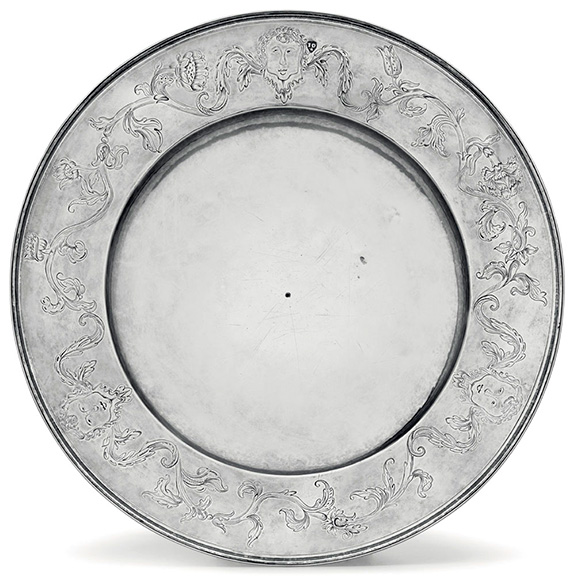
The Diamond-Newmarch-Mugridge engraved silver serving plate with the mark of Jeremiah Dummer of Boston, 1680-1700, sold for $149,000 (est. $150,000/250,000) to Michigan collector Rick Patrick. With a diameter of 11 3/8" and weighing 17 oz., it has a molded border on its wide rim, finely engraved with three stylized cherub’s masks between a meandering leafy vine with tulips, sunflowers, and a carnation. The reverse is engraved with original monogram D over AI, and on the rim is marked with Kane mark A. It is one of only four surviving engraved platters from the early Colonial period, all made in Boston by a group of masters and apprentices working together and probably using a shared print source for the engraving. There is another by Dummer, one by Timothy Dwight, and one by John Coney. The related Dummer platter with one engraved cherub’s head has been owned by Saint Paul’s Episcopal Church in Philadelphia since the late 19th century and has been on loan to the Philadelphia Museum of Art since 1974. It may have been owned by Edward Shippen, who moved from Boston to Philadelphia in 1693.
All of the four plates have engraved rims, and all probably used the same print source for the ornament. Dummer made two of these plates; Timothy Dwight made one, and John Coney made one. The related Dummer plate is owned by St. Paul’s Episcopal Church in Philadelphia and has been on loan to the Philadelphia Museum of Art since 1974. In the catalog for the exhibition Worldly Goods in 1999, curator Jack Lindsey suggested that it was owned by Edward Shippen, who moved to Philadelphia from Boston in 1693. The other two plates are in the collection of the Museum of Fine Arts, Boston.
Christie’s January sales on Friday opened on a high note with a special catalog of Outsider art that added $1,549,375 to Christie’s total. Of the 48 lots offered, 44 sold for a 92% sell-through rate. William Edmondson’s 17" high limestone carving of a boxer, said to represent Joe Louis or perhaps Jack Johnson, sold for an astounding $785,000—a record for Edmondson and a record for Outsider art. The winner on the phone with Andrew Holter of Christie’s is still unknown. The underbidder was collector Jerry Lauren of New York City. The previous auction record for an Edmondson was $263,000 paid at Christie’s in January 2014 for Mother and Child (est. $50,000/80,000). Edmondson has always been a cut above the average Outsider artists; he was discovered early and was the first recognized Outsider artist and first black artist to have a one-man show at the Museum of Modern Art in 1937.
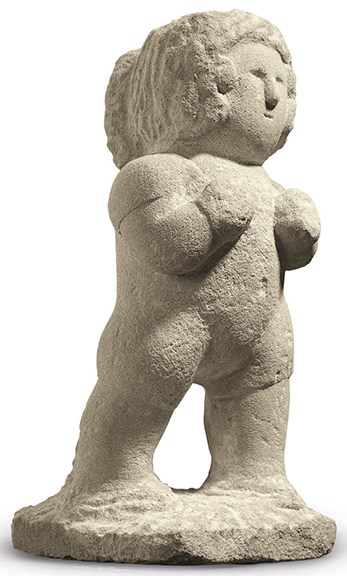
William Edmondson (1874-1951), Boxer, 1936/37, limestone, 17" high, 7¼" wide, 9¼" deep, sold on the phone for $785,000 (est. $150,000/ 250,000), underbid by New York City collector Jerry Lauren. Considered a masterwork by this African American artist, it is likely modeled after Joe Louis or possibly Jack Johnson, the two great black boxers during Edmondson’s lifetime.
Johnson was heavyweight champion from 1908 through 1915. Louis was heavyweight champion from June 1937 to February 1949. This is one of two sculptures of a boxer carved by Edmondson. The other is in the Newark (New Jersey) Museum. The Boxer, one of Edmondson’s favorite works, was photographed by Louise Dahl-Wolfe in 1937 and later by Edward Weston in Edmondson’s yard and was shown at the Museum of Modern Art in 1937, when Edmondson was the first African American to have a solo exhibition at MoMA.
This Boxer was acquired in 1949 by Ruth Denton and remained with her descendants until this sale. This is the highest price thus far paid for a work of Outsider art. The previous auction record for Edmondson was $263,000 paid at Christie’s on January 24, 2014, for Mother and Child.
Collectors in the salesroom and on the phones were the major buyers, some buying multiple works. The collection of Victor Keen, a Philadelphia lawyer, is installed in the Bethany Mission Gallery, a building that once was an old Quaker mission for “colored people,” established in the 1850s to offer opportunities for learning and community assistance programs. Keen exhibits art by self-taught artists along with his other collections of Catalin radios, antique metal toys and banks, milk glass, ceramic pot lids, posters, signs, banners, photographs, and antique toasters and often holds events there. At the sale he bid often and bought five lots: a Martín Ramírez for $75,000 (est. $60,000/100,000), an Adolf Wölfli for $12,500 (est. $10,000/20,000), and an anonymous painting on repurposed wood of a toddler for $6250 (est. $8000/10,000); the toddler painting had a Carl Hammer Gallery and Ricco/Maresco Gallery provenance. He also got George Widener’s Titanic, 22½" x 36", for $22,500, and Justin McCarthy’s Tournament of Roses, 1965, for $1500 (est. $2000/4000).
A phone bidder, number 109, bought seven lots including a James Castle tiny drawing with soot and spit of a farm landscape for $6875 (est. $5000/10,000), a dancing root figure found in New Orleans after Hurricane Katrina for $47,500, and two by Bill Traylor—Man with a Plow for $68,750 and $46,250 for Blue Rabbit Running.
The grand total for Christie’s Americana Week sales, offered in four catalogs, came to $10,857,625 including $2,633,750 for the Zaitz sale on the afternoon just before the silver was offered. It also includes $2,183,625 from the Chinese export art, which sold on January 21. Of the 247 lots of China trade porcelain and paintings offered 160 sold (65% sold by lot). Chinese export porcelain decorated with European subjects from the collection of J. Jefferson Miller of Baltimore performed well. China trade will be covered in a separate story.
For more information, contact Christie’s at (212) 636-2230 or the website (www.christies.com).
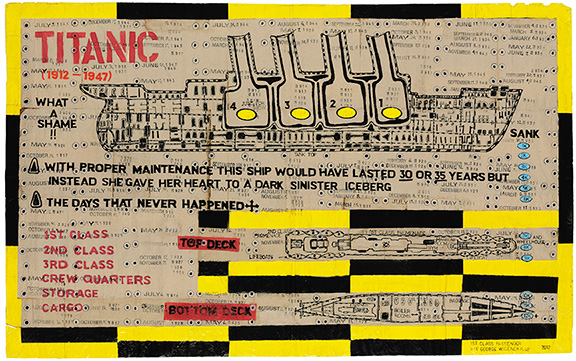
George Widener (b. 1962), Titanic (1912-1947),2012, signed “1st Class Passenger V.I.P. George Widener R.I.P.,”ink and acrylic on pieced paper napkins, 22½" x 36" sold, in the salesroom to Victor Keen, a Philadelphia collector, for $22,500 (est. $8000/12,000). A numerical savant, Widener was diagnosed with Asperger syndrome, and much of his artwork is about the sinking of the Titanic.
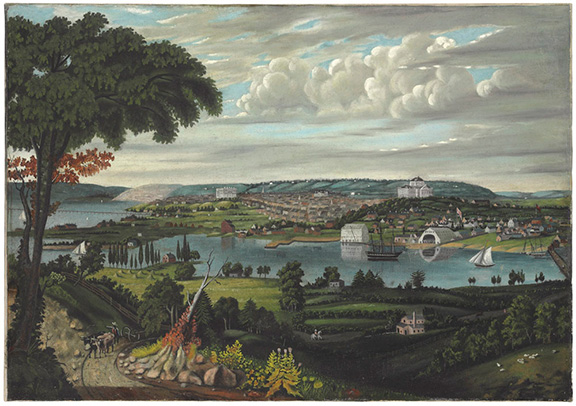
American school, 19th century, The City of Washington from beyond the Navy Yard, oil on canvas, 35" x 50", sold for $32,500 (est. $10,000/15,000) to a bidder online from Virginia. Rosebrook collection.
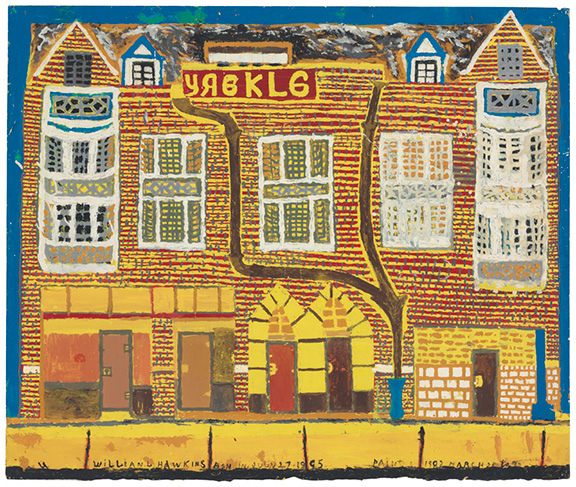
William Hawkins (1895-1990), Yaekle Building, dated 1982, signed and inscribed “WILLIAM. L. HAWKINS BON [sic] IN JULY 27 – 1895 PAINT 1982 MARCH 20 to 30,”enamel and glitter on thick paper, 44" x 52¼". It sold on the phone for $47,500 (est. $20,000/30,000). This is one of approximately five large-scale enamel-on-paper works completed by Hawkins, who rendered three variations of the Yaekle building, a landmark in Columbus, Ohio. One is a promised gift to the Philadelphia Museum of Art. This one was from the collection of Marvin (Mickey) and Jill Baten, known as the Marvill collection, which was shown at the Brooklyn Museum in 1976. In the catalog Frank Maresca and Roger Ricco wrote about the Marvill collection of Outsider art and vernacular sculpture collected by the Batens over four decades.
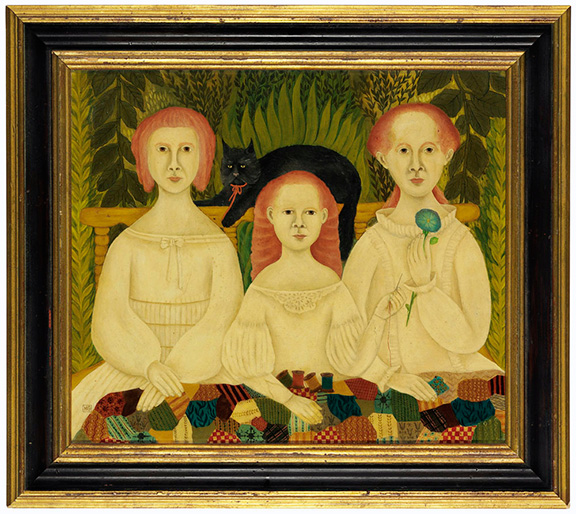
New England, circa 1910, called a “Portrait of Three Ladies with Cat,”initialed “MG,” oil on canvas, 23¼" x 27". It sold online for $30,000 (est. $15,000/20,000). It has an impressive provenance: George Schoelkopf, Don and Faye Walters, Goshen, Indiana; Newcomer /Westreich Gallery, Washington, D.C.; and the Marvill collection.
Originally published in the April 2016 issue of Maine Antique Digest. © 2016 Maine Antique Digest





